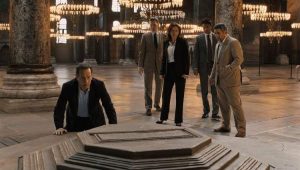![]()
It has been seven years since we last saw author Dan Brown’s puzzle-solving professor on the big screen, in the less-than-thrilling thriller Angels and Demons. I can safely say that the time away hasn’t done the series any favors. This newest tale, Inferno, takes a darker approach, using more nightmarish and horrific imagery to put the world in threat. However, it feels even more ridiculous than previous installments and fairly flat in execution.
 The latest adventure opens with Harvard lecturer Robert Langdon (Tom Hanks) in hospital care, suffering from amnesia and bizarre visions. With no idea how or when he got there, he’s helped by young Dr. Sienna Brooks (Felicity Jones). When an assassin arrives, the two go on the lam, searching for clues as to what is occurring. Langdon is also hunted by old flame Elizabeth Sinskey (Sidse Babett Knudsen), who now works for the World Health Organization. Langdon and Brooks begin to figure out that it all has to do with the imminent release of a lethal virus created by mad billionaire Bertrand Zobrist (Ben Foster).
The latest adventure opens with Harvard lecturer Robert Langdon (Tom Hanks) in hospital care, suffering from amnesia and bizarre visions. With no idea how or when he got there, he’s helped by young Dr. Sienna Brooks (Felicity Jones). When an assassin arrives, the two go on the lam, searching for clues as to what is occurring. Langdon is also hunted by old flame Elizabeth Sinskey (Sidse Babett Knudsen), who now works for the World Health Organization. Langdon and Brooks begin to figure out that it all has to do with the imminent release of a lethal virus created by mad billionaire Bertrand Zobrist (Ben Foster).
It’s a chase movie essentially, with the two leads having to study various works of art and solve clues left for them to find the location of the deadly virus. Which means a lot, and I mean a lot, of awkward exposition. Our leads spend a great deal of time explaining the significance of the works of Dante and Botticelli, what the clues mean, and how they’re solving the puzzles. It feels absurd on several occasions, like the characters are awkwardly explaining their actions to the viewing audience. Perhaps that’s the way it has always been in these films, but it really feels forced here. Of course, it’s also amusing that in addition to being an M.D., Brooks is just as well versed in art history. Sure, a brief explanation for her expertise is given, but it all comes off as outlandish.
 There are attempts to create extra conflict, but they’re not very convincing. At one point, there is even some suggestion that previous to his blackout, Langdon may have been working for the bad guys. The characters may ponder this possibility, but audiences certainly won’t as they wait for our hero to explain away the mystery. While the details are gibberish, the final explanation and big twist is obvious and telegraphed with some strange looks and actions well ahead of time. It also begs a question or two that can’t be asked in print without giving the identities away.
There are attempts to create extra conflict, but they’re not very convincing. At one point, there is even some suggestion that previous to his blackout, Langdon may have been working for the bad guys. The characters may ponder this possibility, but audiences certainly won’t as they wait for our hero to explain away the mystery. While the details are gibberish, the final explanation and big twist is obvious and telegraphed with some strange looks and actions well ahead of time. It also begs a question or two that can’t be asked in print without giving the identities away.
Early on, the movie features a lot of shaky camera work, quick cuts and blurry images to try and communicate Langdon’s memory loss and confusion. It’s overused and not necessary. Thankfully, the technique is forgotten by the second half of the feature and the photography improves dramatically. If I can say little else positive, at least the movie is an impressive travelogue. There are some beautiful locations featured. The Boboli Gardens and Palazzo Vecchio in Florence are beautiful to look at, as are the underwater canals of Istanbul. But I suppose you could also see all of that on a PBS travel doc.
 Additionally, a couple of minor scuffles and pursuits are well handled. The energy level is high, but considering the stakes, what is occurring onscreen never comes off as anything more than silliness. I was particularly amused by the climax, in which an armed government organization attempts to stealthily enter a site with hundreds of innocent people watching a symphony. I’ve never heard characters speak into radios so loudly while moving through a concert hall and not attract any attention from concertgoers.
Additionally, a couple of minor scuffles and pursuits are well handled. The energy level is high, but considering the stakes, what is occurring onscreen never comes off as anything more than silliness. I was particularly amused by the climax, in which an armed government organization attempts to stealthily enter a site with hundreds of innocent people watching a symphony. I’ve never heard characters speak into radios so loudly while moving through a concert hall and not attract any attention from concertgoers.
It all goes to prove the obvious. Inferno is really ridiculous and despite its best efforts can’t be taken seriously as a suspense film for more than a minute or two before something silly is stated or done. It may have worked 10 years ago, but the old and familiar formula isn’t as effective as it used to be. In the end, this movie may have an effective scene or two, but the excitement flames out quickly.


